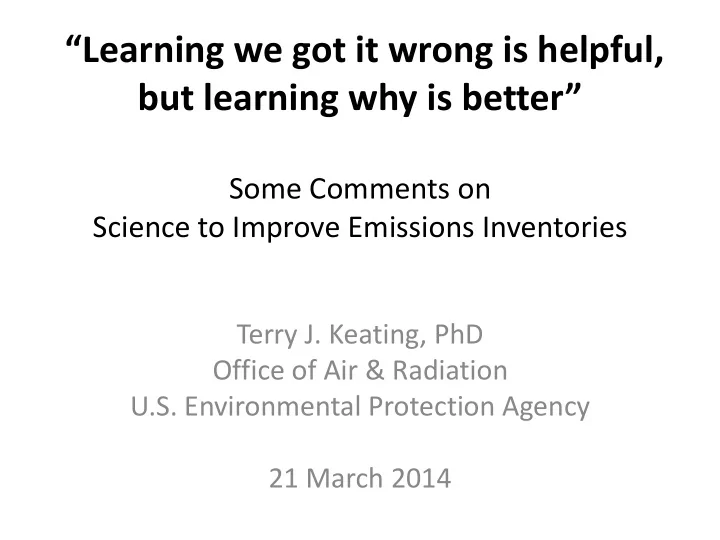

“Learning we got it wrong is helpful, but learning why is better” Some Comments on Science to Improve Emissions Inventories Terry J. Keating, PhD Office of Air & Radiation U.S. Environmental Protection Agency 21 March 2014
Emissions Inventory Development at EPA Criteria Air Pollutants Long-Lived Greenhouse Gases (& Hazardous Air Pollutants) OAR/OAQPS (RTP) OAR/OAP (DC) States and Other Stakeholders UNFCCC Process Spatially Resolved National Totals (at least county level) Produced Every 3 years Produced Annually (v1, 2 yr delay) (2 yr delay) Air Emissions Reporting Rule, Greenhouse Gas Reporting Compliance and Emissions Data Rule Reporting
2005 NARSTO Emissions Inventory Assessment Key Findings & Recommendations 1. Address Priority Emission Inventory Needs Fine particles and their precursors Toxic and hazardous air pollutants Estimated Annual Recommended Additional Onroad motor vehicles Expenditures Expenditures Agricultural sources, especially ammonia Biogenic sources United States $ 25. M $ 35. M Petrochemical and other industrial facilities Canada $ 6. M $ 9. M Off road mobile sources Open biomass burning Mexico $ 0.6 M $ 7. M Residential wood combustion Paved and unpaved road dust 2 . Improve Emission Inventory Speciation Estimates 3. Improve Existing and Develop New Emission Inventory Tools 4. Quantify and Report Uncertainty 5. Increase Emission Inventory Compatibility and Comparability 6. Improve User Accessibility 7. Improve Timeliness 8. Assess and Improve Emission Projections
What is needed to improve inventories? Ambient Concentration = f(Emissions, Dispersion, Transport, Chemistry, Deposition) Emissions = Activity Level x Emissions Factor x Control Factor • Need to understand and articulate uncertainties and limitations of “top - down” and “bottom - up” estimates. • Need to close the loop back to activity level and emissions factors, which goes beyond typical measurement activities/interests. • More Observations: Source Emissions, Ambient Observations, Activity Levels • More Evaluation: Past Trends, Future Projections
Who will make the investment? • Anthropogenic vs. Natural Sources – What is perceived as a “science” activity and what is perceived as a “regulatory” activity? • Public Sector vs. Private Sector Funding – How do we harness private sector interests? • Within the United States vs. Globally
Role of Coordination Activities • Avoiding Duplication and Achieving Better Coverage – Avoiding “Kindergarten Soccer” – Methane example: Current focus is on oil & gas, but we also need more information about agricultural reservoirs, hydroelectric reservoirs, open pit coal mining, forest fires, … – There is a draft interagency methane strategy that is part of the President’s climate action plan. • Understanding Customer Needs – E.g., NOAA’s operational air quality forecasting program: “Can EPA provide updates for modeling purposes more often than NEI base years?” • Understanding Supplier Capabilities – Identifying windows of opportunity in production cycles to make improvements. – Identifying highest priority sources/issues for improvement.
Venues for Coordination • GEIA: The International Community • The Federal Interagency Community: A Work Group under USGCRP and AQRS? – Define appropriate roles for agencies – Help leverage limited funding – Help justify investments by articulating contribution to science and value to applications.
Role of Information Technology • Facilitating Data Access, Data Analysis, and Expert Communication • Challenge of Completeness and Transparency • Central Clearinghouses/Archives vs. Distributed, Interoperable Networks of Systems • Need for Standards/Conventions, Open Source Approaches
GEO Atmospheric Composition/Air Quality Community of Practice Convenors: Martin Schultz (Germany), Terry Keating (US), Rudy Husar (emeritus) Mission: • enabling communication across the air quality and atmospheric research communities globally • contributing to the definition of metadata and data exchange standards • aiding the implementation of interoperable data exchange systems in the context of GEOSS http://wiki.esipfed.org/index.php/GEO_AQ_CoP
Cyberinfrastructure for Air Quality Management (CyAir) Best Practices Guidelines • Introduction to Interoperability • Data Format Standards • Naming Conventions • Web Services • Metadata • Data Publication and Discovery http://wiki.esipfed.org/index.php/CyAirProject 10
North American Online Informational, Interactive Platform on Climate Change Working towards a Tri-National Emissions Inventory for GHGs, Black Carbon, and related Co-Pollutants GHG BC CAC CAN NIR Arctic Council CAN NPRI CAN Emission Trends Assessment US NIR Report to Congress on US NEI US SIT Black Carbon MEX Nat’l MEX INE Communication
North American Online Informational, Interactive Platform on Climate Change Three Core Deliverables: • Data Dictionary (framework for comparison) • Web Services (framework for distribution, application ecosystem) • Web Application (to be demonstrated at GEIA 2014)
North American Black Carbon Emissions Estimation Guidelines Task 1 Literature Review (Nov 2013 – Apr 2014) Thorough review and comparison of data and methodologies Task 2: Expert Consultation (Apr 2014 – Aug 2014) Establishment of consensus methodologies to harmonize and improve North American black carbon emissions inventories Task 3: Guidance Document (Sep 2014 – Apr 2015) Incorporation of these into a user-friendly guidance document
Where will the next global inventory of air pollution emissions come from? • EPA needs global inventories – To provide boundary conditions for U.S. domain – To inform international engagement and evaluate overseas mitigation opportunities • EDGAR is the only “production” global inventory for criteria pollutants. – It is not tied to nationally-reported emissions information. • HTAP “Mosaic” Approach: Replace parts of global inventory with “best” or “official” regional data. – Can we do this in a “production” mode?
Recommend
More recommend